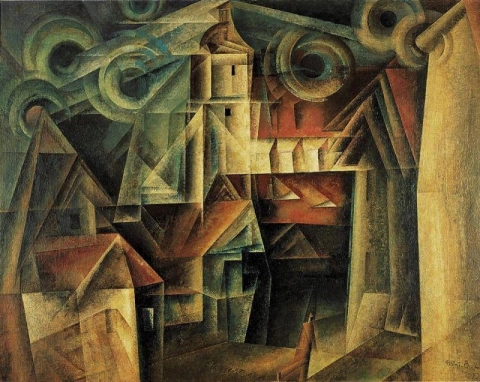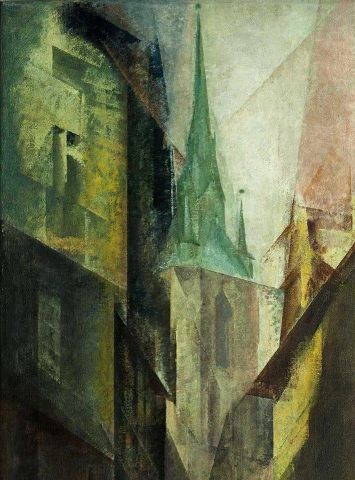

Hand painted reproductions of Lyonel Feininger
Lyonel Feininger: A Visionary German-American Painter of Expressionist and Cubist Art
Lyonel Feininger (1871–1956) was a German-American painter and graphic artist, renowned for his innovative contributions to Expressionism and Cubism. His work merged elements of these movements to create a unique visual language that conveyed the emotional intensity of the modern world. Feininger’s art was celebrated for its vibrant use of color, dynamic geometric forms, and his focus on architecture and landscapes, making him a pivotal figure in the development of 20th-century art.
Early Life and Education
Lyonel Feininger was born in New York City in 1871 to a family of musicians. His early exposure to the arts came through his parents, who both had strong artistic backgrounds. Feininger’s family moved to Germany when he was a young boy, where he grew up and received much of his artistic training. He studied at the Royal Academy of Fine Arts in Berlin, where he refined his skills in both painting and graphic arts.
Initially, Feininger pursued a career in architecture, but his artistic talent soon led him to focus on painting. He studied and worked in various cities, including Berlin and Paris, where he was influenced by the emerging trends of Impressionism and Post-Impressionism. His time in Paris, especially his exposure to the works of Georges Seurat and Paul Cézanne, had a profound effect on his artistic development.
Artistic Development and Style
Feininger’s style evolved over time, reflecting his encounters with multiple artistic movements. Initially influenced by Impressionism, Feininger later turned to Expressionism, eventually merging these influences with elements of Cubism. As a member of the influential Berlin-based group Die Brücke, Feininger explored the emotional power of color and form, and his work conveyed a sense of movement and inner turmoil.
His works, particularly his landscapes and architectural scenes, often feature bold geometric shapes and sharp angles. Feininger’s focus on architecture was inspired by his deep interest in the structure and design of cities, particularly those along the coastlines of Germany. His compositions frequently depicted scenes of towers, churches, and urban streets, transforming them into abstract forms through his distinctive style. He also worked extensively in graphic design, producing woodcuts and lithographs that further explored his interest in geometry and abstraction.
In addition to his architectural themes, Feininger’s works often captured the energy of the city, particularly the dramatic contrasts between light and shadow. His use of color was vivid and expressive, with his landscapes and urban scenes employing rich tones that heightened the emotional content of the compositions.
Themes and Significance
Feininger’s art was deeply connected to his exploration of the modern world and the rapidly changing urban environments of the early 20th century. His depictions of cityscapes and architecture reveal his fascination with the built environment, as well as the tensions between the organic and the constructed world. The jagged, angular lines in his work evoke the energy and dynamism of modern cities, while the use of light and shadow imbues the scenes with a sense of emotional depth.
Feininger’s engagement with Cubism allowed him to represent the fragmented, multi-dimensional nature of the world around him. His architectural forms, once static and solid, became broken into geometric planes and shapes, reflecting the disorienting effects of modernity. At the same time, his Expressionist influences gave his works an emotional resonance, transforming everyday scenes into powerful expressions of the artist’s inner world.
Another key theme in Feininger’s work was his interest in the sea. His coastal landscapes and seascapes, often painted during his time in northern Germany, reflect his connection to nature and the natural world. These works, with their sweeping forms and dramatic skies, were some of the most emotional and evocative pieces in his oeuvre, capturing the sublime power of nature through his dynamic style.
Achievements and Influence
Feininger was one of the most prominent figures in German Expressionism and Cubism, exhibiting his work in major art galleries and exhibitions throughout Europe and the United States. His paintings were displayed at the famous Sturm Gallery in Berlin, which was dedicated to promoting avant-garde art. Feininger also exhibited in New York, Paris, and other major cities, establishing himself as an international artist.
As a member of Die Brücke and later associated with the Bauhaus school, Feininger played an influential role in the development of modern art. His work influenced both the German and American art scenes, particularly in the fields of abstract art and modern graphic design. Feininger’s artistic exploration of form, color, and space paved the way for future developments in abstraction, influencing artists such as Paul Klee, Wassily Kandinsky, and others.
In addition to his success as a painter, Feininger was an accomplished illustrator and graphic artist, known for his woodcuts, lithographs, and etchings. His work in this medium allowed him to experiment further with form and composition, using the graphic arts to explore the same themes he developed in his paintings.
Legacy
Lyonel Feininger’s legacy as a pioneering figure in modern art is secure. His unique fusion of Expressionism, Cubism, and abstraction set him apart as a visionary artist who was deeply engaged with the rapidly changing world around him. His works remain highly regarded for their bold geometric shapes, expressive use of color, and emotional depth.
Today, Feininger’s paintings and graphic works are held in prestigious collections, including the Museum of Modern Art in New York, the Bauhaus-Archiv in Berlin, and the Lyonel Feininger Gallery in Quedlinburg, Germany. His influence on the development of modern abstraction and his ability to capture the energy of the modern world continue to inspire contemporary artists.
Where to Find Reproductions of Lyonel Feininger’s Art
For collectors and art enthusiasts seeking to bring the bold geometric energy of Lyonel Feininger’s works into their own homes, high-quality oil painting reproductions are available. These reproductions capture the vibrant color, intricate forms, and emotional intensity that Feininger infused into his paintings, allowing collectors to experience his modernist vision firsthand.
Imagine owning an original-style painting by one of the greatest artists in history. At POD, we offer you the chance to make this dream a reality. Each canvas is faithfully reproduced down to the smallest detail, allowing you to experience the beauty of the artist’s vision in your own home.
Our reproductions are crafted by experienced painters using the finest materials and time-honored methods. We are committed to delivering works of exceptional quality that will inspire and bring joy to your family for generations to come.















